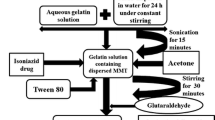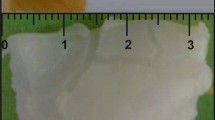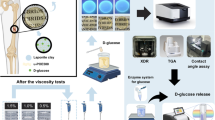Abstract
This study describes the millifluidic-based synthesis of conventional Polyacrylamide (PAM), Polyacrylamide-Sodium Montmorillonite (PAM-NaMMT) and Polyacrylamide-Organo-modified Montmorillonite (PAM-OMMT) composite milligels. These hydrogel particles with millimeter size are intended to be used for the design of Drug Delivery Systems (DDS) combining hydrogels and Clay performances. The composite hydrogels structure, the interactions between the PAM chains and the Clay and the networks thermal behavior were evidenced by Fourier Transform Infrared Spectroscopy (FTIR) and Differential Scanning Calorimetry (DSC) respectively. PAM, PAM-NaMMT and PAM-OMMT milligels potential loading and release of Mebeverine Hydrochloride, taken as a model molecule, was investigated by UV Spectroscopy. This potential was examined as a function of the release medium, the networks chemical composition, the Montmorillonite (MMT) nature and its content.
Access provided by CONRICYT-eBooks. Download conference paper PDF
Similar content being viewed by others

Keywords
1 Introduction
For several years, there has been a growing interest in hydrogels prepared from naturally occuring polymers or synthetic polymers for various applications, ranging from controlled drug release to the tissue engineering developed for the reconstruction of diseased tissues and bone tissues (Alimardan et al. (2014); Tan and Marra (2010); Parida and Mishra (2012); Hoare and Kohane (2008); Thakur et al. (2011)). Hydrogels are macromolecular networks that swell, but not dissolve in water (Ferreira et al. (2001); Dafader et al. (2011); Saraydin et al. (2002)).
Multiparticle systems in controlling and sustaining of release rate of many active pharmaceutical ingredients are the greatest advance in the field of Drug Delivery Systems (DDS) design. As a result oral dosage forms such as microcapsules and microspheres have emerged as DDS for the treatment of various diseases (Patil et al. (2016)). Thus, hydrogels based on different polymers and prepared in the form of beads by different methods have emerged (Topuz and Okay (2009); Rajeswari et al. (2012); Ray et al. (2010); Wan (2012)). One of the innovative techniques for obtaining hydrogel beads is the millifluidic which is the « science of fluids flow in tubes of small diameters ». It is based on the generation of drops in millimeter-scale tubes from the flow of at least two immiscible fluids.
This study deals with the use of the millifluidic technique for the design of a drug delivery system combining hydrogels and Clay performances.
2 Experimental Part
2.1 Montmorillonite Sodium Exchange and Organo-Modification
-
The Clay used in this study is the Montmorillonite of Maghnia (an Algerian Clay) (MMT). First, it was treated with an aqueous solution of NaCl in order to exchange its pristine interlayer cations by Na+. The homoionized Montmorillonite (Sodium Montmorillonite) is noted NaMMT.
-
The organo-modified Montmorillonite noted OMMT was obtained by exchanging the sodium ions of NaMMT by tetradecyltrimethyl ammonium ions C17H38N+.
2.2 Milligels Synthesis
Polyacrylamide milligels PAM, and composite milligels PAM-NaMMT and PAM-OMMT were synthesized using millifluidic device, by in-situ free radical polymerization-cross-linking at 60°C, in aqueous solution and aqueous Clay suspensions respectively, using the initiator Potassium Persulfate (KPS) and the cross-linking agent N,N-methylene-Bis-Acrylamide (Bis). The weight ratios Clay/(Acrylamide monomer AM) selected were 0,5 and 1%. Composite milligels are noted PAM-NaMMTi and PAM-OMMTi (i = 0.5 and 1 = Clay/AM weight ratio).
Figure 1 shows the process of the milligels generation in capillary tubes.
For comparison, the macrogel PAM was synthesized in the same conditions by the conventionnal route.
2.3 Drug Loading and Release
The loading of Mebeverine Hydrochloride onto the three types of milligels was carried out by swelling equilibrium method. Each hydrogel was allowed to swell in the drug solution of known concentration. After the equilibrium loading, the drug release was investigated in acidic (pH = 1,2) and alkaline (pH = 7.4) media to simulate the stomach and the intestine environments. Milligels loading and release kinetics were monitored by UV Spectroscopy. The amount of the drug loaded or released at any given time and in a given medium was calculated from the absorbance of the sample and the calibration curves we previously constructed.
3 Results and Discussion
3.1 FTIR Analysis
3.1.1 PAM Analysis
Polyacrylamide IR spectrum is predominated by two large and intense bands. The first one extends between 3990 cm−1 and 2800 cm−1 and is assigned to asymetrical and symetrical stretching vibrations of N-H groups. The second one extends between 2000 cm−1 and 1480 cm−1 and is attributed to the stretching vibrations of the carbonyl groups (νC = O) and deformation vibrations of the NH bonds (δN-H scissoring). These bands were considered to highlight the effect of the Clay introduction within the PAM network.
The peaks at 2928 cm−1 and 2850 cm−1 are attributed, in the order, to asymetrical and symmetrical stretching vibrations of –CH2 and –CH groups (Fig 2).
3.1.2 The Clay Effect on PAM Structure
Interactions formation or destruction in the PAM network following the introduction of NaMMT or OMMT is demonstrated by the carbonyl regions of PAM-NAMMTi and PAM-OMMTi spectra. These regions showed an increase of C = O and N-H peak intensities ratio, as illustrated, for exemple, by PAM and PAM-NaMMTi regions shown in Fig. 3.
This result could be attributed to the destruction of the interactions between the functional groups of the PAM to the benefit of the establishment of interactions between the PAM amide groups and the negatively charged NaMMT or OMMT sheets.
3.2 Differential Scanning Calorimetry Analysis
Table 1 gathers the glass transition temperature (Tg) values of the PAM, and the composite networks PAM-NaMMTi and PAM-OMMTi. One can note that there is an increase in the PAM Tg value with the introduction of the MMT within its network, whatever is the homoionized or organo-modified nature of the MMT. In the presence of the Clay, polyacrylamide chains become less mobile. The composite networks are more rigid. This fact can be explained by an increase in the cross-links density, induced by the interactions between PAM chains and the MMT sheets.
3.3 Mebeverine Hydrochloride Loading and Release
The loading kinetics obtained showed that the composite milligels load a more important quantity of the Mebeverine Hydrochloride than the PAM, as illustrated by Fig. 4.
The most important result of the Hydrochloride Mebeverine release study pointed out in this study is illustrated by Figs. 5(a), and (b) which show the release kinetics obtained for the composite milligels PAM-NaMMT1 and PAM-OMMT1 compared to the milligels PAM and the macrogel PAM, in the two different media (acid and alkaline). Our finding shows that:
-
the behavior of the polyacrylamide network is insensitive to pH;
-
the composite milligels are pH-sensitive.
4 Conclusions
This work aimed the development of drug loading-release systems combining hydrogels and Clay performances. In this perspective we have synthesized the conventional hydrogel polyacrylamide PAM and the composite hydrogels Polyacrylamide-Sodium Montmorillonite PAM-NaMMT and Polyacrylamide -Organo-modified Montmorillonite PAM-OMMT. These hydrogels were synthesized in the form of millimetric sized beads on the basis of an adapted droplet-flow millifluidic process. The FTIR analysis highlighted the interactions developed between the functional amide groups of the polyacrylamide and the sheets of the Clay. This result was corroborated by the DSC analysis which showed the reduction of the PAM chains mobility in the presence of the Montmorillonite as a result of the establishment of new junctions. Mebeverine Hydrochloride loading-release kinetics showed that PAM, PAM-NaMMTi and PAM-OMMTi potential drug load and release is modulated by the networks chemical composition. The drug release kinetics showed that we succeeded in designing a pH-sensitive Drug Release System which can be used to control the Mebeverine Hydrochloride release.
References
Alimardan, Z., Darabi, M., Natori, R.: Drug delivery of indomethacin in use nature starch based nanocomposite hydrogel in vitro. Int. J. Biosci. 5, 51–56 (2014)
Tan, H., Marra, K.G.: Injectable, biodegradable hydrogels for tissue engineering applications. Materials 3, 1746–1767 (2010)
Parida, P., Mishra, S.C.: Synthesis, crosslinking and evaluation of graft polymer for biomedical use. Res. Rev.: J. Pharm. Sci. 3, 37–45 (2012)
Hoare, T.R., Kohane, D.S.: Hydrogels in drug delivery: progress and challenges. Polymer 49, 1993–2007 (2008)
Thakur, A., Wanchoo, R.K., Singh, P.: Hydrogels of poly (acrylamide -co-acrylic acid): in-vitro study on release of gentamicin sulfate. Chem. Biochem. Eng. Q. 25, 471–482 (2011)
Ferreira, L., Vidal, M.M., Gil, M.H.: Design of a drug-delivery system based on polyacrylamide hydrogels. Evaluation of structural properties. Chem. Educ. 6, 100–103 (2001)
Dafader, N.C., Adnan, M.N., Haque, M.E., Huq, D., Akhtar, F.: Study on the properties of copolymer hydrogel obtained from acrylamide/2-hydroxyethyl methacrylate by the application of gamma radiation. Afr. J. Pure Appl. Chem. 5, 111–118 (2011)
Saraydin, D., Isikver, Y., Karadag, E., Sahiner, N., Guven, O.: In vitro dynamic swelling behaviors of radiation synthesized polyacrylamide with crosslinkers in the simulated physiological body fluids. Nucl. Insrum. Methods Phys. Res. B 187, 340–344 (2002)
Patil, J.S., Kole, S.G., Gurav, P.B., Vilegave, K.V.: Natural polymer based mucoadhesive hydrogel beads of nizatidine preparation, characterization and evaluation. Indian J. Pharm. Educ. Res. 50, 159–169 (2016)
Topuz, F., Okay, O.: Macroporous hydrogel beads of high toughness and superfast responsivity. React. Funct. Polym. 69, 273–280 (2009)
Rajeswari, K.R., Abbulu, K., Sudhakar, M., Karki, R., Rajkumar, B.: Development and characterization of valsartan loaded hydrogel beads. Der Pharmacia Lettre 4, 1044–1053 (2012)
Ray, R., Maity, S., Mandal, S., Chatterjee, T.K., Sa, B.: Development and Evaluation of a New Interpenetrating Network Bead of Sodium Carboxymethyl Xanthan and Sodium Alginate for Ibuprofen Release. Pharmacol. Pharm. 1, 9–17 (2010)
Wan, J.: Microfluidic-based synthesis of hydrogel particles for cell microencapsulation and cell-based drug delivery. Polymers 4, 1084–1108 (2012)
Author information
Authors and Affiliations
Corresponding author
Editor information
Editors and Affiliations
Rights and permissions
Copyright information
© 2018 Springer International Publishing AG
About this paper
Cite this paper
Baït, N., Grassl, B., Benaboura, A. (2018). Milligels Synthesis and Characterization: Mebeverine Hydrochloride Uptake and Release. In: Abdelbaki, B., Safi, B., Saidi, M. (eds) Proceedings of the Third International Symposium on Materials and Sustainable Development. SMSD 2017. Springer, Cham. https://doi.org/10.1007/978-3-319-89707-3_43
Download citation
DOI: https://doi.org/10.1007/978-3-319-89707-3_43
Published:
Publisher Name: Springer, Cham
Print ISBN: 978-3-319-89706-6
Online ISBN: 978-3-319-89707-3
eBook Packages: Chemistry and Materials ScienceChemistry and Material Science (R0)








